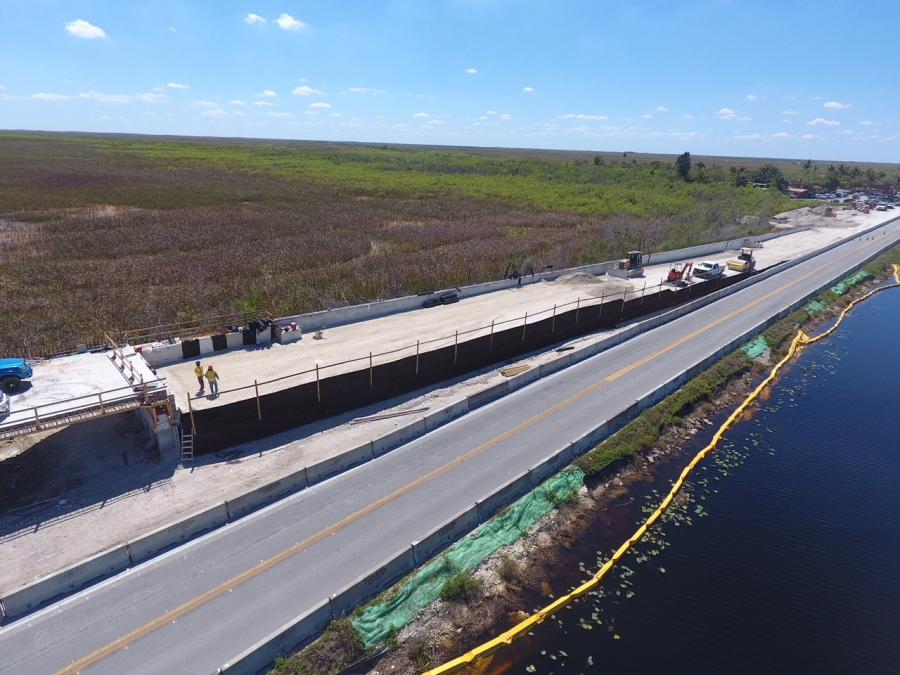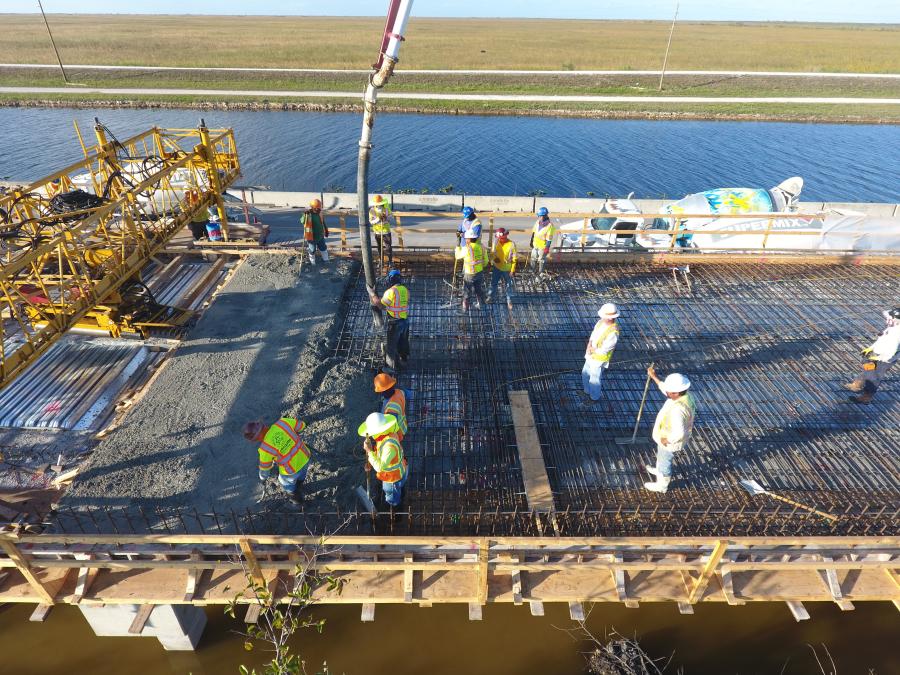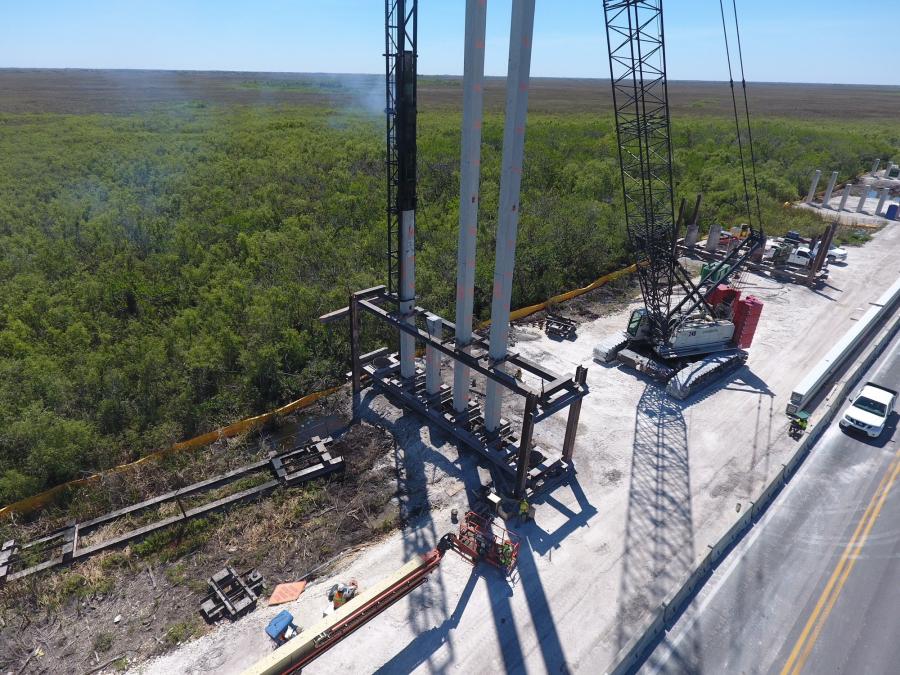The $69.5 million project started in August 2016 and is scheduled to be completed this December.
The Everglades National Park is undergoing a Florida Department of Transportation (FDOT)/National Park Service partnership initiative to provide additional freshwater flow within the swamp and improve the ecological conditions in the park and in the central Everglades, north of Tamiami Trail.
The $69.5 million project started in August 2016 and is scheduled to be completed this December. The design-build process will see the construction of two new bridges along SW 90/U.S. 41/SW 8 Street/Tamiami Trail from east of Osceola Camp to west of the Airboat Association of Florida.
 In addition to building new bridges immediately south of the existing roadway, the work also includes raising a section of roadway where the bridges touch down near Everglades Safari Park to maintain access to the property and removing the section of existing Tamiami Trail roadway next to the new bridges.
In addition to building new bridges immediately south of the existing roadway, the work also includes raising a section of roadway where the bridges touch down near Everglades Safari Park to maintain access to the property and removing the section of existing Tamiami Trail roadway next to the new bridges.
“When complete the 2.6-mile bridge and roadway improvements will allow for increased flow from the L-29 canal into Everglades National Park,” said Charles Borders, the NPS's project manager. “The 2.2 miles of unconstrained flow will significantly improve the flow of fresh water, provide for ecological connectivity and increase the distribution in Shark Slough within the park.”
The project is a joint-venture that unites Condotte America Inc. and Stantec Inc., an engineering firm that designed the bridges and road upgrades.
“One of the project challenges has been transporting the bridge beams and piles to the project corridor,” said Francis Chin Sr., the project's senior project engineer of F&J Engineering Group, representing FDOT. “The beams are 140 feet and the longest piles are 130 feet, and they have traveled to the corridor on special trucks. Concrete bridges are being constructed using concrete pile bents, cap and deck. The bridges are a Florida I-beam design because it's an efficient type of bridge to construct and materials are readily available in South Florida.”
The lifespan of the bridges and infrastructure is about 75 years.
“The span lengths of the bridges are approximately 140 feet,” said Chin. “Choosing this span length is an efficient way to build the bridge while minimizing impacts to the environment.”
Traffic-wise, one lane may be closed during non-peak daytime and nighttime hours. Flaggers are being used to help guide drivers through the work zone.
Condotte America expects to complete the entire project the end of 2018.
“One of the unique project characteristics is the project location — both accessing the project daily and work zones within the corridor,” said Matt M. Sturm, Condotte America's project manager. “And the fact that the project is directly in the National Park Services requires more detailed attention to the surrounding area. Everyone on site is required to go through an environmental orientation that assists in identifying potential species that may be encountered. Additionally, the project team includes a full-time environmental scientist to guide the workers and assist in dealing with any wildlife encounters.
“Utility coordination was addressed during the design phase” he added. “Now as the work progresses, we still need to coordinate our efforts with those the utility contractors selected to perform their work. Due to the location of the project, there are logistical constraints, so we try to schedule our major deliveries, so the materials are immediately placed and not required to be stored on site.
The West bridge is 7,565-ft.-long with two lanes in each direction and a 10-ft. shoulder, while the East bridge is 4,650-ft.-long with two lanes in each direction and a 10-ft shoulder.
“The contractor is currently slightly ahead of schedule,” said Chin. “It's been a great collaboration with team members to build this project safely, while minimizing impacts to the environment and traveling public. The roadwork is proceeding well. The contractor will salvage any reusable material and properly disposes unsuitable material at a designated site. Great care was taken to install and maintain erosion control devices and frequent inspections are conducted by all parties including the permit agencies to ensure compliance.”
 Some of the subcontractors involved in the project are: American Pipeline for underground utilities; Florida Concrete Products for pre-cast piles, caps and beams; Concrete Services for concrete traffic barrier; and Halley Engineering Contractors Inc. for asphalt paving.
Some of the subcontractors involved in the project are: American Pipeline for underground utilities; Florida Concrete Products for pre-cast piles, caps and beams; Concrete Services for concrete traffic barrier; and Halley Engineering Contractors Inc. for asphalt paving.
There are nearly 100 construction workers on site on a daily basis.
Condotte America is using a variety of cranes, dozers, excavators, rollers and pavers.
“The equipment used on site does encounter daily wear and tear,” said Sturm, “but Condotte has an ample amount of mechanics for our fleet.”
CEG
Irwin Rapoport
A journalist who started his career at a weekly community newspaper, Irwin Rapoport has written about construction and architecture for more than 15 years, as well as a variety of other subjects, such as recycling, environmental issues, business supply chains, property development, pulp and paper, agriculture, solar power and energy, and education. Getting the story right and illustrating the hard work and professionalism that goes into completing road, bridge, and building projects is important to him. A key element of his construction articles is to provide readers with an opportunity to see how general contractors and departments of transportation complete their projects and address challenges so that lessons learned can be shared with a wider audience.
Rapoport has a BA in History and a Minor in Political Science from Concordia University. His hobbies include hiking, birding, cycling, reading, going to concerts and plays, hanging out with friends and family, and architecture. He is keen to one day write an MA thesis on military and economic planning by the Great Powers prior to the start of the First World War.
Read more from Irwin Rapoport here.
Today's top stories










 In addition to building new bridges immediately south of the existing roadway, the work also includes raising a section of roadway where the bridges touch down near Everglades Safari Park to maintain access to the property and removing the section of existing Tamiami Trail roadway next to the new bridges.
In addition to building new bridges immediately south of the existing roadway, the work also includes raising a section of roadway where the bridges touch down near Everglades Safari Park to maintain access to the property and removing the section of existing Tamiami Trail roadway next to the new bridges. Some of the subcontractors involved in the project are: American Pipeline for underground utilities; Florida Concrete Products for pre-cast piles, caps and beams; Concrete Services for concrete traffic barrier; and Halley Engineering Contractors Inc. for asphalt paving.
Some of the subcontractors involved in the project are: American Pipeline for underground utilities; Florida Concrete Products for pre-cast piles, caps and beams; Concrete Services for concrete traffic barrier; and Halley Engineering Contractors Inc. for asphalt paving.






